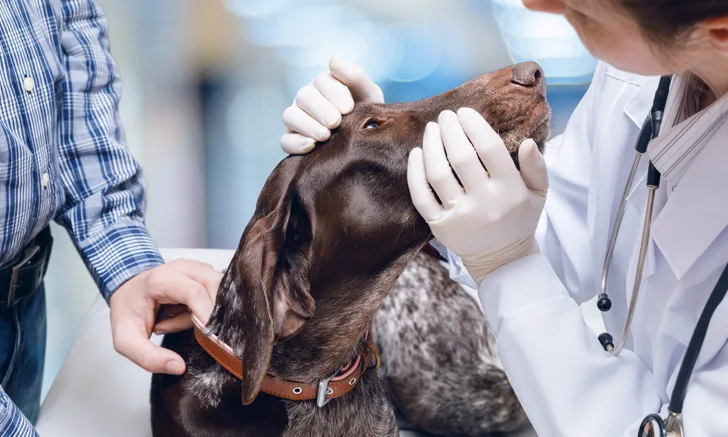
In the Literature
Bercovitz GR, Gaerig AM, Conway ED, et al. Long-lasting otic medications may be a rare cause of neurogenic keratoconjunctivitis sicca in dogs. J Am Vet Med Assoc. 2023;261(1):97-103. doi:10.2460/javma.22.07.0301
The Research …
Canine neurogenic keratoconjunctivitis sicca (nKCS; ie, neurogenic dry eye) is uncommon and caused by disruption of efferent lacrimal gland innervation. Affected dogs have clinical signs of severe dry eye (eg, blepharospasm, conjunctival hyperemia, chemosis, ocular discharge, Schirmer tear test <15 mm/minute), often with concurrent ulcerative keratitis. Ipsilateral xeromycteria (ie, dry nares) is variably present. There are numerous possible causes of nKCS, but otitis media and trauma are commonly implicated.
This case series described clinical characteristics, common findings, and outcomes of possible ocular adverse reactions to long-lasting otic medications containing terbinafine and florfenicol. All dogs (n = 29) developed clinical signs consistent with nKCS within 1 day of otic medication application, suggesting a causal relationship. Most dogs (68%) had concurrent corneal ulceration, and all had a low Schirmer tear test (<15 mm/minute) at one point during monitoring. Approximately half of the dogs (48%) had ipsilateral xeromycteria, and 34% had concurrent neurologic abnormalities (eg, vestibular disease, facial nerve paralysis, hearing loss).
The majority of dogs (83%) had a return of normal lacrimal function in a median of 86 days. Oral or topical ocular treatment with pilocarpine, a parasympathomimetic, was used in 65% of dogs, but there was no obvious clinical benefit. Dogs presented with deep corneal ulceration were more likely to take longer to recover lacrimal function.
The authors speculated nKCS was caused by penetration of otic medications into the middle ear through a perforated tympanic membrane that resulted in facial nerve damage. Tympanic membrane visualization was attempted in only 45% of dogs prior to otic medication administration, and the membrane was visualized in 54% of these cases. The authors recommend complying with label recommendations to evaluate the tympanic membrane prior to application of medications that contain terbinafine and florfenicol.
Limitations of this study were its small size, failure to rule out other causes of nKCS (eg, hypothyroidism, diabetes mellitus), and inability to rule out progression of otitis as the primary cause of nKCS.
… The Takeaways
Key pearls to put into practice:
nKCS appears to be a rare adverse effect of long-lasting otic medication administration in dogs. nKCS developed quickly (within 1 day) following administration of long-lasting otic medications that contained terbinafine and florfenicol.
Most dogs recovered lacrimal function with or without treatment with pilocarpine, and most required treatment for concurrent corneal ulceration.
Dogs with nKCS and concurrent deep corneal ulceration may have a more protracted recovery.
When possible, tympanic membrane integrity should be confirmed prior to administration of medication to reduce the likelihood of adverse effects.
If nKCS occurs following administration of long-lasting otic medication, the medication should be cleaned from the ear canal and ocular lesions treated as they develop.
You are reading 2-Minute Takeaways, a research summary resource presented by Clinician’s Brief. Clinician’s Brief does not conduct primary research.